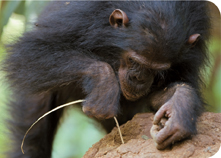Learned Behavior
 What are the major types of learning?
What are the major types of learning?
If all behaviors were innate, animals would have a tough time adapting to unpredictable changes in their environments. (And if all behavior were innate, you wouldn't be reading this book!) Many complex animals live in unpredictable environments, where their fitness can depend on behaviors that can be altered as a result of experience. Acquiring changes in behavior during one's lifetime is called learning.
Many animals have the ability to learn. Organisms with simple nervous systems, such as sea stars, shrimp, and most other invertebrates, may learn only rarely. Among a few invertebrates, and many chordates, learning is common and occurs under a wide range of circumstances. In animals that care for their young, for example, offspring can learn behaviors from their parents or other caretakers. The chimpanzee in Figure 29–2 is exhibiting a complex learned behavior—using a tool to gather food. Scientists have identified several different ways of learning.  The four major types of learning are habituation, classical conditioning, operant conditioning, and insight learning.
The four major types of learning are habituation, classical conditioning, operant conditioning, and insight learning.
Habituation The simplest type of learning is habituation. Habituation is a process by which an animal decreases or stops its response to a repetitive stimulus that neither rewards nor harms the animal. Often, learning to ignore a stimulus that offers neither a reward nor a threat can enable an individual to spend its time and energy more efficiently. Consider the common shore ragworm, an invertebrate shown to be capable of simple learning. This animal lives in a sandy tube that it leaves to feed. If a shadow passes overhead, the worm will instantly retreat to the safety of its burrow. Yet, if repeated shadows pass within a short time span, this response quickly subsides. When the worm has learned that the shadow is neither food nor threat, it will stop responding. At this point the worm has been habituated to the stimulus. In Figure 29–3, you can see birds becoming habituated to the stimulus of passing cars.

FIGURE 29–2 Learned Behavior This chimpanzee is using a stick as a tool to “fish” for termites in a termite nest.

FIGURE 29–3 Habituation Birds on the side of a road take flight when a car approaches (left). After many cars have passed and not harmed them, these birds have become habituated to cars, and they no longer take flight when one approaches (right).
Table of Contents
- Formulas and Equations
- Applying Formulas and Equations
- Mean, Median, and Mode
- Estimation
- Using Measurements in Calculations
- Effects of Measurement Errors
- Accuracy
- Precision
- Comparing Accuracy and Precision
- Significant Figures
- Calculating With Significant Figures
- Scientific Notation
- Calculating With Scientific Notation
- Dimensional Analysis
- Applying Dimensional Analysis




